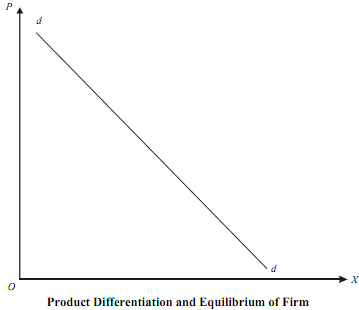Chamberlin's approach to equilibrium:
1) Assumptions
The basic assumptions of Chamberlin's large group model are the same as those of pure competition with the exception of the homogeneous product.
They are as follows:
i) There are a large number of sellers and buyers in the 'group'
ii) There is free entry and exit in the group
iii) The goal of the firm is profit maximisation both in the short-run and long-run
iv) The products of the seller are differentiated, yet they are close substitute of each other
v) The prices of factors and technology are given
vi) The firm is assumed to behave as if it knew its demand and cost curves with certainty
vii) The long-run consists of a number of identical short-run periods, which are assumed to be independent of each other. It implies decisions of present period do not affect that of the future. Neither they are affected by that of past period's.
viii) Finally, Chamberlin makes his 'heroic' assumption that both demand and cost curves for all products are uniform throughout the group. This requires that consumer preferences are evenly distributed among the sellers and the cost conditions (even though products are differentiated) are same in among the producers.
2) Cost Curves
The average variable cost (AVC), marginal cost (MC) and the average total cost (ATC) curves are "U" shaped. This implies there is a single output level, which is optional (note: the output level corresponding to the minimum point of ATC is called the optimal output level). Chamberlin introduced the concept of 'selling cost', which is incurred to promote the sell of a product. He assumed that it is 'U' shaped.

3) Demand Curves
While Sraffa first introduced that product differentiation could be a basis for downward sloping demand curve, Chamberlin suggested that demand is not determined by the prices alone. Apart from price, the selling activities and the product itself are the major determinants of demand, according to Chamberlin. The effect of product differentiation is that the producer has some discretion in the determination of prices. The producer is not a price taker but she enjoys some degree of monopoly power.
4) Equilibrium of the Firm
As a result of product differentiation, the demand curve of an individual firm is negatively sloped. If the firm increases its price, it will lose some of its customers. However, by reducing price if will attract new customers, who were customers to other firms. Since there are large number of firms, if one firm reduces price the loss of other firms (as they loose customer) will be negligible. Thus, other firms might be indifferent to price charged by a single firm. The demand curve dd is drawn on the above assumption that firms would not change or react to individual firms price decisions.
In short, Chamberlin-firm acts like a monopolist and maximises its profit equating MR and MC. Chamberlin developed two different models of equilibrium. In the first model, the existing firms are in short run equilibrium realising supranational profits. They do not have any incentive to change their prices. In the second model, it is assumed that the member of firms in the industry is optimal and long run equilibrium is achieved by price adjustments. The third model is a combination of the first two, where long run equilibrium is achieved by price adjustments by the existing firms and by new entry.